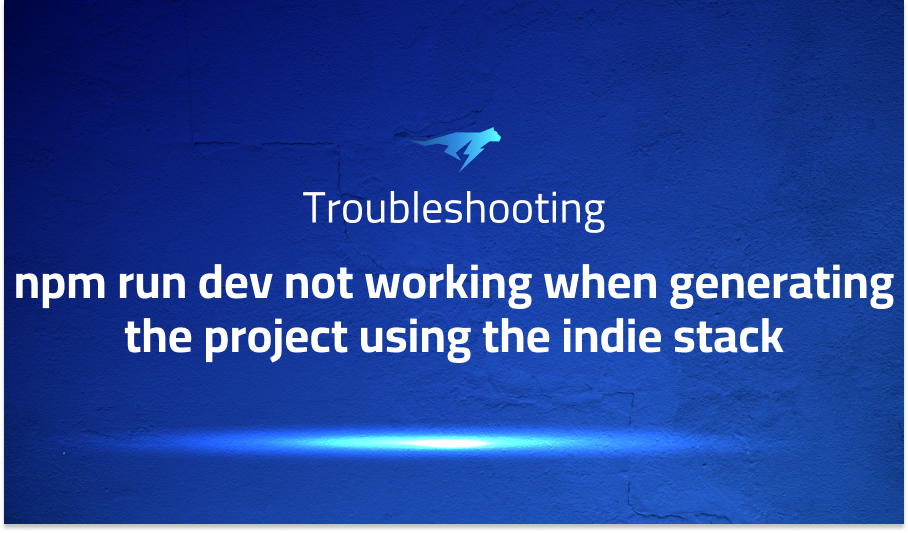

npm run dev not working when generating the project using the indie stack
Explanation of the problem
The reported issue relates to using the latest version of Remix, a web framework for building JavaScript applications. The problem occurs when following the provided documentation and attempting to run a specific command to create a Remix project. The user is instructed to execute the command npx create-remix --template remix-run/indie-stack blog-tutorial in either Powershell or Git Bash. The command initiates the project setup process, selecting TypeScript as the language option and proceeding with the installation of required dependencies. After navigating into the newly created blog-tutorial/ directory, the user runs the command npm run dev to start the local development server. However, instead of the expected behavior of the server running at localhost:3000, an error is encountered, preventing the successful execution of the development server.
Upon running npm run dev, the error message indicates an issue with the execution of the dev:remix script. This script, responsible for starting the Remix development server, utilizes the @remix-run/dev:remix package with additional configuration provided via the cross-env package. The error message specifically states that there is a problem with the syntax of the filename, directory name, or volume label. This error prevents the dev:remix script from running successfully, resulting in the failure of the dev command. As a consequence, the expected behavior of the local development server spawning at localhost:3000 is not achieved.
Troubleshooting with the Lightrun Developer Observability Platform
Getting a sense of what’s actually happening inside a live application is a frustrating experience, one that relies mostly on querying and observing whatever logs were written during development.
Lightrun is a Developer Observability Platform, allowing developers to add telemetry to live applications in real-time, on-demand, and right from the IDE.
- Instantly add logs to, set metrics in, and take snapshots of live applications
- Insights delivered straight to your IDE or CLI
- Works where you do: dev, QA, staging, CI/CD, and production
Start for free today
Problem solution for error when npm run dev not working when generating the project using the indie stack
One of the top answers suggests a solution to the reported issue by downgrading the version of npm from 8.13.0 to 8.12.2. The user shares their experience and states that after performing the downgrade, the problem is resolved, and the desired functionality is now working as expected. They provide a command to execute, npm install -g npm@8.12.2, which installs the specific version of npm mentioned. This solution is obtained from a source on Stack Overflow, indicating that it has been successful for others facing a similar problem.
By downgrading npm to version 8.12.2, the user likely addresses a compatibility issue or bug that exists in the newer version (8.13.0) and causes the reported error. The specific nature of this compatibility issue is not mentioned, but it can be inferred that the downgrade resolves the problem and allows the command npm run dev to function correctly. Downgrading npm versions is a common troubleshooting approach when encountering unexpected behavior or compatibility issues in projects, as it provides an alternative environment that may better support the project’s requirements.
Other popular problems with Remix-run React Router
Problem: Inconsistency in navigation behavior when using useNavigate() in React Router v6.
When navigating to the same route but with different parameters using useNavigate() function, the component does not re-render as expected. This issue is specific to React Router v6 and can cause confusion and unexpected behavior in the application.
Solution:
A possible solution is to use the useEffect hook and the useLocation hook to manually update the component state and trigger a re-render upon navigation.
Code block:
import { useEffect, useState } from 'react';
import { useNavigate, useLocation } from 'react-router-dom';
function QuestionDetailsPage() {
const navigate = useNavigate();
const location = useLocation();
const [questionId, setQuestionId] = useState(null);
useEffect(() => {
setQuestionId(location.pathname.split('/').pop());
}, [location]);
return (
<div>
<h1>Question: {questionId}</h1>
<button onClick={() => navigate(`/questions/${questionId + 1}`)}>Next</button>
</div>
);
}
Problem: Confusion between the different types of routers available in React Router.
React Router offers three types of routers, namely BrowserRouter, HashRouter, and MemoryRouter, each with their own specific use cases and behaviors. This can lead to confusion and unexpected behavior when using the wrong type of router for a particular situation.
Solution:
It is important to understand the differences between the three types of routers and choose the appropriate one for your use case. For example, if you want to use client-side routing and want the router to handle the history of your application, use BrowserRouter. If you want to use server-side rendering, then MemoryRouter is best suited.
Code block:
import { BrowserRouter, HashRouter, MemoryRouter } from 'react-router-dom';
function App() {
return (
<BrowserRouter>
{/* Your application code */}
</BrowserRouter>
);
}
A brief introduction to Remix-run React Router
Remix-run React Router is a library that provides routing capabilities for React applications. It allows developers to define and navigate between different routes within the application, which are typically mapped to different components or pages. The library is built on top of the React ecosystem and works seamlessly with other popular React libraries and tools. One of the key features of React Router is its flexibility and ability to handle different types of routing, including browser and hash routing, dynamic parameters, and programmatic navigation.
A key benefit of using React Router is that it abstracts away the complexities of handling browser navigation, allowing developers to focus on building the logic and functionality of their application. This improves the developer experience and enables them to create scalable, maintainable, and performant applications.
Most popular use cases for Remix-run React Router
- React Router can be used to handle client-side routing in a React application. This allows for navigation between different pages or views of the app without requiring a full page reload.
import { BrowserRouter, Route } from 'react-router-dom';
function App() {
return (
<BrowserRouter>
<Route exact path="/" component={HomePage} />
<Route path="/about" component={AboutPage} />
</BrowserRouter>
)
}
- It also provides features such as dynamic route matching and URL parsing, allowing for the passing of parameters between routes and the ability to extract information from the current URL.
import { useParams } from 'react-router-dom';
function ProductPage() {
let { productId } = useParams();
// productId will have the value of the id parameter in the URL
return <div>Product: {productId}</div>;
}
- React Router also allows for the creation of protected routes and the handling of redirects, making it easier to implement authentication and authorization in a React application.
import { Route, Redirect } from 'react-router-dom';
function PrivateRoute({ component: Component, ...rest }) {
return (
<Route
{...rest}
render={props =>
isAuthenticated ? (
<Component {...props} />
) : (
<Redirect
to={{
pathname: '/login',
state: { from: props.location }
}}
/>
)
}
/>
);
}It’s Really not that Complicated.
You can actually understand what’s going on inside your live applications.




